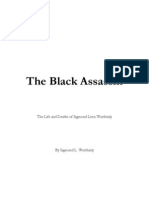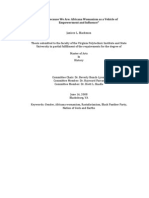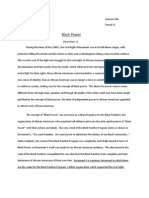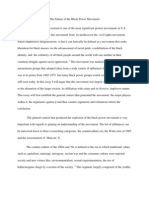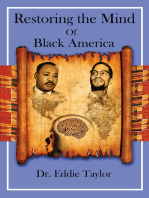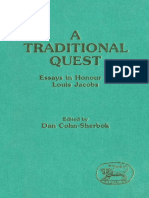Black Masculinity
Black Masculinity
Uploaded by
3rinl33Copyright:
Available Formats
Black Masculinity
Black Masculinity
Uploaded by
3rinl33Original Title
Copyright
Available Formats
Share this document
Did you find this document useful?
Is this content inappropriate?
Copyright:
Available Formats
Black Masculinity
Black Masculinity
Uploaded by
3rinl33Copyright:
Available Formats
“Don't Let Me Be Misunderstood”: Ruminations on Teaching Black Masculinity in the
United States
Author(s): Courtney L. Thompson
Source: Women, Gender, and Families of Color , Vol. 6, No. 1, Trump's America?
Disquiet Campus? Marginalized College Students, Faculty, and Staff Reflect on Learning,
Working, Living, and Engaging (Spring 2018), pp. 103-109
Published by: University of Illinois Press
Stable URL: https://www.jstor.org/stable/10.5406/womgenfamcol.6.1.0103
JSTOR is a not-for-profit service that helps scholars, researchers, and students discover, use, and build upon a wide
range of content in a trusted digital archive. We use information technology and tools to increase productivity and
facilitate new forms of scholarship. For more information about JSTOR, please contact support@jstor.org.
Your use of the JSTOR archive indicates your acceptance of the Terms & Conditions of Use, available at
https://about.jstor.org/terms
University of Illinois Press is collaborating with JSTOR to digitize, preserve and extend access
to Women, Gender, and Families of Color
This content downloaded from
128.59.222.107 on Fri, 21 Dec 2018 02:52:05 UTC
All use subject to https://about.jstor.org/terms
“Don’t Let Me Be Misunderstood”: Ruminations on
Teaching Black Masculinity in the United States
Courtney L. Thompson, The University of the South
This innocent country set you down in a ghetto in which, in fact, it
intended that you should perish. Let me spell out precisely what I mean
by that, for the heart of the matter is here, and the root of my dispute with
my country. You were born where you were born and faced the future that
you faced because you were black and for no other reason. The limits of
your ambition were, thus, expected to be set forever. You were born into a
society which spelled out with brutal clarity, and in as many ways as pos-
sible, that you were a worthless human being.
—James Baldwin, The Fire Next Time (7)
To be black in the Baltimore of my youth was to be naked before the ele-
ments of the world, before all the guns, fists, knives, crack, rape, and
disease. The nakedness is not an error, nor pathology. The nakedness is
the correct and intended result of policy, the predictable upshot of people
forced for centuries to live under fear. The law did not protect us.
—Ta-Nehisi Coates, Between the World and Me (17)
I
n The Fire Next Time (1963), James Baldwin offers a cogent critique of the
status of black men in the United States. In his analysis, he bemoans the way
black male subjectivity is perceived as expendable and, as a consequence,
equated with nothingness. Baldwin draws our attention to the reality that,
in American law and life, black lives have been misconstrued as worthless,
deemed socially inferior, and vilified as unfit to serve in any capacity other
than that of a subordinate. Ta-Nehisi Coates’s most salient observations about
black manhood in Between the World and Me (2015), penned a little over
50 years later, resonate with Baldwin’s assertion that society is purposely
structured in a way that excludes black men. Without mincing words, Coates
describes an unmistakable “nakedness” that exposes the condition of blacks,
Courtney L. Thompson is an assistant professor at the University of the South. She identi-
fies as a black woman from a working-class background.
Women, Gender, and Families of Color Spring 2018, Vol. 6, No. 1 pp. 130–109
©2018 by the Board of Trustees of the University of Illinois
This content downloaded from
128.59.222.107 on Fri, 21 Dec 2018 02:52:05 UTC
All use subject to https://about.jstor.org/terms
WGFC 6_1 text.indd 103 6/6/18 11:02 AM
104 thompson
revealing that they have been stripped of the rights and responsibilities—in
effect, the benefits—associated with citizenship. Taken together, a striking
parallel emerges between these two texts as they denounce a racially stratified
society that engenders sustained attacks on black bodies from one genera-
tion to the next.
After a turbulent year marked by civil unrest and massive protests in cit-
ies across the nation in response to the senseless killings of unarmed black
men and women, I felt compelled to offer an undergraduate course that
focused on black masculinity in the United States.1 I envisioned an intellec-
tually discursive space where students could begin to confront some of the
perceptions of black men found in the news, on social media, and within
their neighborhoods and communities. For some students, interpreting and
grappling with mainstream representations of black men was nothing new.
Either they self-identified as black men, or they had spent a good deal of
their lives exposed to black men in the form of fathers, uncles, brothers,
cousins, and friends. For other students, their racial identities and social
locations prevented them from understanding the experiences of black men
beyond the superficial. They did not know firsthand about the dimensions
of black manhood or how these dimensions impacted the daily lives of black
men—regardless of socioeconomic status, sexuality, religious orientation, or
ability. They were not black; neither did they have black grandfathers, fathers,
brothers, or uncles; some did not even have black friends.
In the wake of what felt like an onslaught of state-sanctioned violence
that targeted black men and women, the constant negation of black identity
as marked in nuanced and complex ways led me to think carefully about
protester Ali Delan’s plea: “We need answers for Michael Brown.”2 By exten-
sion, I reasoned that we needed answers for us all. As an educator striving to
be both conscious and compassionate, I felt I had a responsibility to affirm
black identity, defend its fluidity, and participate constructively in dialogues
intended to advance a broader discourse on blackness. I was committed to
using my sphere of influence—albeit a small and unassuming classroom—to
foster progressive, student-centered exchanges about black manhood that
would prompt students to think critically, and in some cases introspectively,
about the plight of black men, their families, and their communities.
We needed to theorize democracy in order to enhance and expand our
collective understanding of what it meant to be a black man in the twenty-
first century. By contemplating American identity from the standpoint of
black men, we would be challenging the ways in which essentialist notions
of democratic practice rendered black men invisible and undermined their
rights as citizens. I envisioned an integrative course that would generate
This content downloaded from
128.59.222.107 on Fri, 21 Dec 2018 02:52:05 UTC
All use subject to https://about.jstor.org/terms
WGFC 6_1 text.indd 104 6/6/18 11:02 AM
spring 2018 / women, gender, and families of color 105
thought-provoking and informative conversations about an increasingly
toxic sociopolitical climate in which racial antipathy was running high. While
some on campus interpreted the loss of black lives as insignificant, others
discerned troubling patterns that gave whole communities pause and sum-
moned a spirit of righteous indignation—rage—that could not be suppressed.
With few outlets, this anguish and pain materialized in protests, rebellions,
and uprisings across the nation.
Few students had the intellectual tools to unpack the deeply troubling
scenes that were unfolding right before their eyes—scenes of innocent and
unarmed black men and women being killed, poor people and people of
color being systematically denied due process under the law, and social
unrest that sometimes devolved into more violence and the destruction of
property. Seldom could I identify students who felt competent enough to
consider the ramifications of being black and male in a culture that, from
its inception, had devalued black maleness. As a faculty member at a small,
elite, predominantly white liberal arts college, I knew that I could not leave
the questions that many of my students had about black men, and why they
were routinely perceived as dangerous and threatening, unanswered.
Given the liberal arts tradition, which is rooted in a commitment to
ideological diversity and the perception of colleges and universities as milieus
where critical inquiry occurs, I was prepared to engage in conversations
about racial bias. I wanted to deal constructively with the ambivalence and
resistance among students whose worldviews differed significantly from my
own. Though incensed about the unexplained deaths of unarmed black men
and women, I did not want to be antagonistic. I recognized that a compre-
hensive and sustained dialogue about the systematic dehumanization of black
lives in the United States would only occur in the span of a semester. As a
self-identified black woman instilled with working-class values, developing a
course that focused primarily on the experiences of black men felt daunting
but necessary. As I began to compile the readings for the course, I sifted at
times through reflections and analyses that I had no idea existed but were
clearly in conversation with each other. I became even more sensitive to the
fact that, in the minds of some traditional thinkers, I would be transgressing
certain cultural boundaries and gender norms.
The learning objectives were ambitious. As students deliberated over the
realities of living in a hierarchical society wherein whiteness was considered
normative and therefore privileged, I wanted them to understand how this
circumstance impacted the ways in which they moved through the world and
how others, through no fault of their own, were forced to navigate a very differ-
ent terrain. More specifically, I wanted students to investigate the historical and
This content downloaded from
128.59.222.107 on Fri, 21 Dec 2018 02:52:05 UTC
All use subject to https://about.jstor.org/terms
WGFC 6_1 text.indd 105 6/6/18 11:02 AM
106 thompson
contemporary delineations of black manhood in order to think comparatively
about how these representations have shifted and/or remained consistent in
American culture and society. An awareness of the political, economic, social,
and cultural factors that influenced definitions of black masculinity was essen-
tial to developing a real rather than imagined understanding of it. While the
challenges that black men negotiated in their daily lives would be clear from
studying their experiences, it was also important for students to consider the
contours of black men’s agency. Identifying the coping strategies that many
black men utilize to survive a hostile climate in which they are routinely scru-
tinized, marginalized, criminalized, and pathologized would be critical. By the
end of the semester, students would be able to demonstrate an understanding
of the relationship between mainstream perceptions of black men as violent
and menacing, criminal minded, and sexually irrepressible, and the social
realities that circumscribed black men’s daily lives.
From the beginning, I recognized the benefits of centering the perspec-
tives of black men whose political, sexual, religious, professional, and class
identities varied. Within the dominant narrative, there is a tendency to repre-
sent identities that exist along the periphery in ways that are static rather than
complex and evolving. While I acknowledged that there were commonalities
that existed among black men that were worth noting, integrating first-person
narratives that would highlight the richness and breadth of the experiences
of black men was a core objective. We needed to explore the ways in which
black men’s experiences overlapped and the ways that they diverged.
The black autobiographical tradition provides an alternative narrative of
black identity and creates a broader context in which to understand blackness
by disrupting what Toni Morrison aptly describes as the “master narrative”
that is reinforced by white paternalism and the misguided notion that black
people are better explained by others or left misunderstood.3 It articulates
what it means to be a black man from the perspectives of those who are
most familiar with this reality, not because of what they have studied but
because of what they have withstood. Given the ways in which black men’s
lives and their very survival against the odds subverts the racial status quo,
which denigrates and demeans black bodies indiscriminately, it is not a large
jump logically to interpret the survival of black men as an act of resistance or
their narratives as symbolic of this ongoing struggle. In To Tell a Free Story,
William L. Andrews maintains,
As black autobiography necessarily establishes its relationship to the essen-
tial texts of oppressive American culture, it also becomes a revisionistic
instrument in the hands of its greatest practitioners. It urges re-vision of the
This content downloaded from
128.59.222.107 on Fri, 21 Dec 2018 02:52:05 UTC
All use subject to https://about.jstor.org/terms
WGFC 6_1 text.indd 106 6/6/18 11:02 AM
spring 2018 / women, gender, and families of color 107
myths and ideals of America’s culture-defining scriptures while it demands
new sight of white readers to recognize the ways in which autobiography
has become a mode of Afro-American scripture. (986, 14)
Andrews’s description of black autobiography emphasizes the way in which it
provides a counternarrative to the established texts of the American regime.
The overall condition of blacks historically necessitated the circulation of
literature (specifically narratives) that expressed their humanity and col-
lective desire for freedom and liberation.4 Often in the academy, there is a
palpable tension between knowledge that is gleaned from experience and
knowledge that is believed to be theoretical or more objective. Given the
centrality of the oral tradition in African American culture, I knew that
omitting the voices of the men whose lives we intended to explore would be
counterproductive.5 Using autobiographical texts, I tried to challenge the
notion that personal experience is not a basis for understanding, navigating,
and analyzing the world. As a consequence, we developed an appreciation
for standpoint theory, and, rather than leading to definitive or conclusive
ways of constructing black masculinity, this framework highlighted how
fluid these constructions tend to be.6
As I reflect on my experiences teaching this course, I feel a deep sense
of gratitude to the men whose lives we explored. Although some of these
men were public figures, many were living their lives without accolades or
recognition of any sort. While politics often determine which stories are told,
it takes heart to surrender parts of one’s private self to public scrutiny. For
this reason, those who have been historically silenced, dismissed, or rendered
inconsequential—yet dare to express what it means to be themselves—should
be celebrated.
Every semester that I have the opportunity to teach this course, I learn
something new. Predictably, there are the insights derived from rereading
and juxtaposing the texts against each other, but I also learn from the stu-
dents who come to the class with a range of expectations and experiences;
their levels of investment as the semester progresses are just as telling. The
perspectives that we bring, those that we examine, and those that we embrace
enable this course to be transformative.
Courses, whether electives or required, should have a purpose that extends
beyond the classroom. “Black Masculinity in the United States” has helped
students become more culturally aware, consider diverse perspectives, and
complicate their understanding of the world by rethinking how it works. It
also fosters social awareness that gains new meaning when students leave the
classroom and venture into the world. Students learn skills in the course that
This content downloaded from
128.59.222.107 on Fri, 21 Dec 2018 02:52:05 UTC
All use subject to https://about.jstor.org/terms
WGFC 6_1 text.indd 107 6/6/18 11:02 AM
108 thompson
are transferable—whether talking to people about their lives and centering
these perspectives or thinking comparatively about the ways in which our
lived experiences are not necessarily universal nor should they be in order
to count.
My desire is that students leave the course feeling more knowledgeable
and better equipped to champion social justice issues that may not affect
them directly but impact the lives of those who are equally human. For
many students, this course will serve as a point of departure for delving
more deeply into the lives of others; for some, this course will prompt them
to take a stand and respond when they notice injustice happening whether
in private or public.
While many in the professoriate have the good fortune of teaching courses
that connect to their research interests, we do not always have the opportunity
to imagine, develop, and teach courses for the common good that address
pressing social issues and speak directly to the human condition. In this
respect, I have had an abundance of riches. My training as an interdisciplin-
ary scholar whose work is concerned with race, gender, and class has made
it possible to approach critical social issues in creative and innovative ways
that not only challenge my own thinking but the thinking of my students. In
the life of the mind, this is where push comes to shove. Intellectually, nothing
is more gratifying.
Notes
1. According to Swaine et al. (2015), “Young black men were nine times more likely
than other Americans to be killed by police officers in 2015, according to the findings of a
Guardian study that recorded a final tally of 1,134 deaths at the hands of law enforcement
officers this year. . . . Despite making up only 2% of the total U.S. population, African
American males between the ages of 15 and 34 comprised more than 15% of all deaths
logged this year by an ongoing investigation into the use of deadly force by police. Their
rate of police-involved deaths was five times higher than for white men of the same age.”
2. According to Somashekhar and Rich (2016), “The [Washington] Post found that the
vast majority of those shot and killed by police were armed and half of them were white.
Still, police killed blacks at three times the rate of whites when adjusted for the popula-
tions where these shootings occurred. And although black men represent 6 percent of the
U.S. population, they made up nearly 40 percent of those who were killed while unarmed.”
3. See Bill Moyers’s interview with Toni Morrison, “Toni Morrison on Love and Writing.”
A World of Ideas, PBS, March 11, 1990.
4. The role of black artists has long been debated. See Li (2015), Gerald (1976), Catlett
(1975), Wright (1937), Hughes (1926), and Du Bois (1926).
5. According to Anokye (1997), African Americans come from a “rich oral tradition”
(230).
This content downloaded from
128.59.222.107 on Fri, 21 Dec 2018 02:52:05 UTC
All use subject to https://about.jstor.org/terms
WGFC 6_1 text.indd 108 6/6/18 11:02 AM
spring 2018 / women, gender, and families of color 109
6. In “Standing at the Crossroads of Modernist Thought,” Mann and Kelley (1997)
describe standpoint theory as “an approach that argues that knowledge is and should
be situated in people’s diverse social locations. As such, all knowledge is affected by the
social conditions under which it is produced; it is grounded in both the social location
and the social biography of the observer and observed” (392).
References
Andrews, William L. To Tell a Free Story: The First Century of Afro-American Autobiography,
1760–1865. Champaign: University of Illinois Press, 1986.
Anokye, A. Duku. “A Case for Orality in the Classroom.” The Clearing House 70, no. 5
(1997): 229–31.
Baldwin, James. The Fire Next Time. New York: Vintage International, 1993.
Catlett, Elizabeth. “The Role of the Black Artist.” The Black Scholar 6, no. 9 (1975): 10–14.
Coates, Ta-Nehisi. Between the World and Me. New York: Spiegel & Grau, 2015.
Du Bois, W. E. B. “Criteria of Negro Art.” Crisis 32, no. 6 (1926): 290, 292, 294, 296–97. Avail-
able at http://www.webdubois.org/dbCriteriaNArt.html?__hstc=223762052.192084a
ac03c316b99a378baecb70229.1369743639772.1369743639772.1369743639772.1&__
hssc=223762052.1.1369743639773, accessed April 9, 2018.
Gerald, Carolyn. “The Black Writer and His Role.” Journal of Non-White Concerns in Person-
nel and Guidance 4, no. 3 (1976): 133–39.
Hughes, Langston. “The Negro Artist and the Racial Mountain.” The Nation, 1926. Available
at http://www.english.illinois.edu/maps/poets/g_l/hughes/mountain.htm, accessed
March 10 2018.
Li, Stephanie. “Black Literary Writers and Post-Blackness.” The Trouble with Post-Black-
ness. New York: Columbia University Press, 2015.
Mann, Susan A., and Lori R. Kelley. “Standing at the Crossroads of Modernist Thought:
Collins, Smith, and New Feminist Epistemologies.” Gender & Society 11, no. 4 (1997):
391–408.
Simone, Nina. “Don’t Let Me Be Misunderstood.” Broadway-Blues-Ballads. CD. Phillips,
1963.
Somashekhar, Sandhya, and Steven Rich. “Final Tally: Police Shot and Killed 986
People in 2015.” Washington Post, January 6, 2016. Retrieved from https://www
.washingtonpost.com/national/final-tally-police-shot-and-killed-984-people-in
-2015/2016/01/05/3ec7a404-b3c5–11e5-a76a-0b5145e8679a_story.html?utm_term
=.72f92cc1e751, accessed March 10, 2018
Swaine, Jon, Oliver Laughland, Jamiles Lartey, and Ciara McCarthy. “Young Black Men
Killed by US Police at Highest Rate in Year of 1, 134 Deaths.” The Guardian (Manchester,
UK), December 31, 2015. Retrieved from https://www.theguardian.com/us-news/2015/
dec/31/the-counted-police-killings-2015-young-black-men, accessed April 9, 2018.
Wright, Richard. “The Blueprint for Negro Writing.” New Challenge: A Literary Quarterly
2, no. 1 (1937): 53–65.
This content downloaded from
128.59.222.107 on Fri, 21 Dec 2018 02:52:05 UTC
All use subject to https://about.jstor.org/terms
WGFC 6_1 text.indd 109 6/6/18 11:02 AM
You might also like
- Sisters of The Yam - Black Women and Self-Recovery (PDFDrive)Document263 pagesSisters of The Yam - Black Women and Self-Recovery (PDFDrive)Jessica MatiasNo ratings yet
- Research 8 Quarter 1 Module 1Document26 pagesResearch 8 Quarter 1 Module 1Angelica Marvie100% (3)
- ENG-106 English Composition II Course SyllabusDocument21 pagesENG-106 English Composition II Course Syllabusbonnie reese100% (1)
- Tainted How Philosophy of Science Can Expose Bad Science PDFDocument313 pagesTainted How Philosophy of Science Can Expose Bad Science PDFRoberto Inguanzo100% (1)
- Post Traumatic Slave SyndromeDocument9 pagesPost Traumatic Slave Syndromebonebody100% (1)
- Hidden Rules Among ClassesDocument1 pageHidden Rules Among Classesapi-209836486No ratings yet
- Bigots With BadgesDocument16 pagesBigots With Badgesmikekvolpe100% (2)
- How To Keep A Black Man DownDocument2 pagesHow To Keep A Black Man DownGarryNo ratings yet
- Racial Sexual Desires HalwaniDocument18 pagesRacial Sexual Desires Halwaniww100% (1)
- Olaudah EquianoDocument14 pagesOlaudah EquianoMYKRISTIE JHO MENDEZNo ratings yet
- Booker T. and W.E.B EssayDocument3 pagesBooker T. and W.E.B Essayjudytcap2017No ratings yet
- Health and Safety Management Systems - ArchiveDocument250 pagesHealth and Safety Management Systems - ArchiveMohamad ZackuanNo ratings yet
- Black Male Privilege ChecklistDocument6 pagesBlack Male Privilege ChecklistPaulNo ratings yet
- Black Panther Party and The Rise of The Crips and Bloods in L.A.Document134 pagesBlack Panther Party and The Rise of The Crips and Bloods in L.A.Luke CageNo ratings yet
- Why A Black Man Should Marry A White WomenDocument9 pagesWhy A Black Man Should Marry A White WomenArtimus Quick Sr.No ratings yet
- The Black AssassinDocument21 pagesThe Black AssassinThe Black AssassinNo ratings yet
- Black PantherDocument6 pagesBlack Panthereomo_usohNo ratings yet
- Black Men Better UnderstoodDocument18 pagesBlack Men Better UnderstoodGian Fiero100% (1)
- The Slave LawsDocument11 pagesThe Slave Lawshanna100% (1)
- The Role of Black Consciousness in The Experience of Being Black in South-Mphikeleni Mattew MnguniDocument136 pagesThe Role of Black Consciousness in The Experience of Being Black in South-Mphikeleni Mattew MngunimylesNo ratings yet
- Class Status and The Construction of Black MasculinityDocument15 pagesClass Status and The Construction of Black MasculinityAnonymous wKjrBAYRoNo ratings yet
- Criminalization of The Black MaleDocument7 pagesCriminalization of The Black MaleVictoria HolmesNo ratings yet
- How Jews Became BlackDocument13 pagesHow Jews Became BlackWillie Johnson100% (1)
- Malcolm X Model of Personal Transformation CRSNDocument4 pagesMalcolm X Model of Personal Transformation CRSNLe Disciple Du LionNo ratings yet
- Arab Views of Black Africans and Slavery PDFDocument24 pagesArab Views of Black Africans and Slavery PDFDamean SamuelNo ratings yet
- Martin Vs MalcolmDocument17 pagesMartin Vs Malcolmronnda100% (3)
- 5 Fallacies of RacismDocument2 pages5 Fallacies of RacismMichael Muhammad100% (1)
- Black SexualityDocument8 pagesBlack SexualityTanima KumariNo ratings yet
- AfrocentricityDocument245 pagesAfrocentricityapi-341091476No ratings yet
- Matrix (Willie Lynch Letter)Document5 pagesMatrix (Willie Lynch Letter)KEITH BNo ratings yet
- Let's Make A Slave by Willie LynchDocument20 pagesLet's Make A Slave by Willie LynchDonnaveo Sherman0% (1)
- Cult of DomesticityDocument3 pagesCult of Domesticityapi-340115266No ratings yet
- James L. Conyers - Molefi Kete Asante - A Critical Afrocentric ReaderDocument262 pagesJames L. Conyers - Molefi Kete Asante - A Critical Afrocentric ReaderAlan Alaafin Paixão100% (1)
- A Recommended Reading List - Understand and Then EmpowerDocument2 pagesA Recommended Reading List - Understand and Then EmpowerFOCBML100% (2)
- Race War v2 - Wake 2019Document32 pagesRace War v2 - Wake 2019ConnorNo ratings yet
- At Africana Womanism - Nikol Alexander-Floyd and Evelyn SimienDocument24 pagesAt Africana Womanism - Nikol Alexander-Floyd and Evelyn Simienben_crossan7673100% (1)
- I Am Because We Are: Africana Womanism As A Vehicle of Empowerment and Influence - by Janiece L. BlackmonDocument58 pagesI Am Because We Are: Africana Womanism As A Vehicle of Empowerment and Influence - by Janiece L. Blackmon☥ The Drop Squad Public Library ☥100% (2)
- Jackson SPDocument18 pagesJackson SPShanice ThompsonNo ratings yet
- Hip Hop Is Satan WorshipDocument25 pagesHip Hop Is Satan WorshipJack Brown100% (1)
- The Marcus Garvey and UNIA Papers Project A UCLA African Studies Center Projects ExtractsDocument7 pagesThe Marcus Garvey and UNIA Papers Project A UCLA African Studies Center Projects Extractshostcares9No ratings yet
- Post Traumatic Slave Syndrome Joy Deruy Type Up Dor DR ColemanDocument3 pagesPost Traumatic Slave Syndrome Joy Deruy Type Up Dor DR Colemanapi-267517008100% (1)
- A Subaltern Middle Class - Revision 1Document13 pagesA Subaltern Middle Class - Revision 1Antonio Moore100% (1)
- DahomeyDocument9 pagesDahomeyRommelBaldago100% (1)
- Slave NarrativesDocument202 pagesSlave Narrativeschrifoti100% (2)
- 5 Things White Women Do That Black Women Can't Get Away WithDocument4 pages5 Things White Women Do That Black Women Can't Get Away Withebitechukwudi0% (1)
- White SupremacismDocument25 pagesWhite SupremacismIván100% (1)
- 5 Positive Leadership Traits People Can Learn From EaglesDocument5 pages5 Positive Leadership Traits People Can Learn From EaglesLawrence Ngari100% (1)
- Michelle Alexander's Speeches On The New Jim CrowDocument20 pagesMichelle Alexander's Speeches On The New Jim CrowPensées Noires100% (2)
- Vita Wa Watu 11Document49 pagesVita Wa Watu 11Mosi Ngozi (fka) james harrisNo ratings yet
- Akinyele Umoja - Armed Self-Defense, Revolutionary Nationalism, and The Southern Black Freedom StruggleDocument24 pagesAkinyele Umoja - Armed Self-Defense, Revolutionary Nationalism, and The Southern Black Freedom StruggleIggyPunk100% (1)
- The Impact of ProstitutionDocument6 pagesThe Impact of ProstitutionLea TanNo ratings yet
- The Myth of The Absent Black Father - ThinkProgress PDFDocument4 pagesThe Myth of The Absent Black Father - ThinkProgress PDFBishara Wilson0% (1)
- Jim Crow Laws - HomeworkDocument2 pagesJim Crow Laws - HomeworkPavelNo ratings yet
- Black Liberation: A Comparative History of Black Ideologies in The United States and South Africa (PDFDrive)Document401 pagesBlack Liberation: A Comparative History of Black Ideologies in The United States and South Africa (PDFDrive)Maks imilijanNo ratings yet
- Treatment of SlavesDocument13 pagesTreatment of Slavesadolfo2100% (2)
- 5 67T'ShakaDocument20 pages5 67T'ShakaObi Dennar100% (2)
- Black FeminismDocument52 pagesBlack Feminismmongo_beti471No ratings yet
- Black Wall StreetDocument2 pagesBlack Wall StreetBeka Shakur100% (1)
- Black Power: (Question 1)Document5 pagesBlack Power: (Question 1)Joonsoo KimNo ratings yet
- The Failure of The Black Power MovementDocument5 pagesThe Failure of The Black Power MovementAndre RobinsonNo ratings yet
- The Politics of Black MemoryDocument8 pagesThe Politics of Black Memoryafrometrics100% (1)
- Unburdened by Conscience: A Black People's Collective Account of America's Ante-Bellum South and the AftermathFrom EverandUnburdened by Conscience: A Black People's Collective Account of America's Ante-Bellum South and the AftermathNo ratings yet
- Sanchez LlamasDocument72 pagesSanchez Llamas3rinl33No ratings yet
- Icci V E Tefano: Heryl Arris BstractDocument30 pagesIcci V E Tefano: Heryl Arris Bstract3rinl33No ratings yet
- Redaction Studio - Keyboard Shortcuts PDFDocument1 pageRedaction Studio - Keyboard Shortcuts PDF3rinl33No ratings yet
- FH FIW 2017 Report FinalDocument28 pagesFH FIW 2017 Report Final3rinl33No ratings yet
- An Organic Law TheoryDocument66 pagesAn Organic Law Theory3rinl33No ratings yet
- Ga Res 27th SessDocument6 pagesGa Res 27th Sess3rinl33No ratings yet
- Loving v. VirginiaDocument12 pagesLoving v. Virginia3rinl33No ratings yet
- Causes of Salvadoran Migration To The United StatesDocument13 pagesCauses of Salvadoran Migration To The United States3rinl33No ratings yet
- Program PlanningDocument2 pagesProgram Planning3rinl33No ratings yet
- Literature & Law Reading Schedule - Fall 2018Document1 pageLiterature & Law Reading Schedule - Fall 20183rinl33No ratings yet
- SYLLABUS - Lit LawDocument4 pagesSYLLABUS - Lit Law3rinl33No ratings yet
- Globalization and Sovereignty: Berkeley Journal of International LawDocument26 pagesGlobalization and Sovereignty: Berkeley Journal of International Law3rinl33No ratings yet
- P.Weis Convention Status Stateless PersonsDocument11 pagesP.Weis Convention Status Stateless Persons3rinl33No ratings yet
- Astute Hero and Ingenious Poet - Odyssey and HomerDocument13 pagesAstute Hero and Ingenious Poet - Odyssey and Homer3rinl33No ratings yet
- Physics For Anesthesiologists From Daily Life To.55Document1 pagePhysics For Anesthesiologists From Daily Life To.55marielaesquermedinaNo ratings yet
- Applied Economic - Quarter 1 - Module 1 (Week1) ###Document10 pagesApplied Economic - Quarter 1 - Module 1 (Week1) ###Sabiniya SakenNo ratings yet
- PHD THESIS - An Analytical Study of Some Problems of Literary Translation PDFDocument214 pagesPHD THESIS - An Analytical Study of Some Problems of Literary Translation PDFRashid YahiaouiNo ratings yet
- Silos in Higher Education Institutions - Shifting From OrganizatioDocument153 pagesSilos in Higher Education Institutions - Shifting From OrganizatioArabella Gaye Dela CruzNo ratings yet
- Daniel C. Cohn-Sherbok A Traditional Quest Essays in Honor of Louis Jacobs JSOT Supplement 1991 PDFDocument241 pagesDaniel C. Cohn-Sherbok A Traditional Quest Essays in Honor of Louis Jacobs JSOT Supplement 1991 PDFVeteris Testamenti Lector100% (1)
- A Scientific Approach To Engineering DesignDocument15 pagesA Scientific Approach To Engineering DesignMusdah MMNo ratings yet
- American Context Realism Naturalism Louis J BuddDocument26 pagesAmerican Context Realism Naturalism Louis J BuddJahfar Sadiq PoochengalNo ratings yet
- FOM Unit-1Document46 pagesFOM Unit-1Gagan ChoudharyNo ratings yet
- Learning Styles GuideDocument44 pagesLearning Styles GuideScribdTranslationsNo ratings yet
- Beswick, David - Cognitive Motivation - From Curiosity To Identity, Purpose and Meaning-Cambridge University Press (2019)Document398 pagesBeswick, David - Cognitive Motivation - From Curiosity To Identity, Purpose and Meaning-Cambridge University Press (2019)UlisesRochaNo ratings yet
- Study Regulation For Nordic Urban Planning Studies: Cand - SocDocument36 pagesStudy Regulation For Nordic Urban Planning Studies: Cand - Socananraj choudhuryNo ratings yet
- Scruton 1987Document16 pagesScruton 1987jpl.guedes6842No ratings yet
- Name Shella Grace Mutya Grade & Section: 12-HEDocument9 pagesName Shella Grace Mutya Grade & Section: 12-HEShella Grace MutyaNo ratings yet
- (Abner Shimony) The Search For A Naturalistic WorlDocument350 pages(Abner Shimony) The Search For A Naturalistic WorllocozuNo ratings yet
- The Essence of Dynamic Capabilities and Their Measurement: Ola Laaksonen and Mirva PeltoniemiDocument22 pagesThe Essence of Dynamic Capabilities and Their Measurement: Ola Laaksonen and Mirva PeltoniemiPrado LucgmailNo ratings yet
- Typical and Atypical Motor Development 1st Edition David Sugden 2024 Scribd DownloadDocument80 pagesTypical and Atypical Motor Development 1st Edition David Sugden 2024 Scribd Downloadbabongbianor100% (4)
- Criterion ABCD For MYP4 5Document6 pagesCriterion ABCD For MYP4 5R DIZZYNo ratings yet
- Assessing The State-of-the-Art in Conflict Transformation: Cordula ReimannDocument23 pagesAssessing The State-of-the-Art in Conflict Transformation: Cordula ReimannHobGadlingNo ratings yet
- Emily FyfeDocument18 pagesEmily FyfeSUSANA LOHRNo ratings yet
- Human Resource Management and Innovation in SMEsDocument18 pagesHuman Resource Management and Innovation in SMEsNita YalinaNo ratings yet
- Assessment Paper Setting & ApprovalDocument8 pagesAssessment Paper Setting & ApprovalRutvik HNo ratings yet
- Semi 2009 049Document28 pagesSemi 2009 049Andreea Robu-MovilaNo ratings yet
- Prosthetic Theory Disciplining of Architecture - WigleyDocument25 pagesProsthetic Theory Disciplining of Architecture - WigleyJillian SproulNo ratings yet
- (Studies in Literary Criticism and Theory) Sarah Gendron-Repetition, Difference, and Knowledge in The Work of Samuel Beckett, Jacques Derrida, and Gilles Deleuze-Peter Lang (2008)Document209 pages(Studies in Literary Criticism and Theory) Sarah Gendron-Repetition, Difference, and Knowledge in The Work of Samuel Beckett, Jacques Derrida, and Gilles Deleuze-Peter Lang (2008)anatecarNo ratings yet
- 3-Steps in Social ResearchDocument10 pages3-Steps in Social ResearchUmer FarooqNo ratings yet
- Sørensen & Torfing - 2011 - Enhancing Collaborative Innovation in The Public Sector - PDFDocument27 pagesSørensen & Torfing - 2011 - Enhancing Collaborative Innovation in The Public Sector - PDFpromotions.shrunkNo ratings yet















